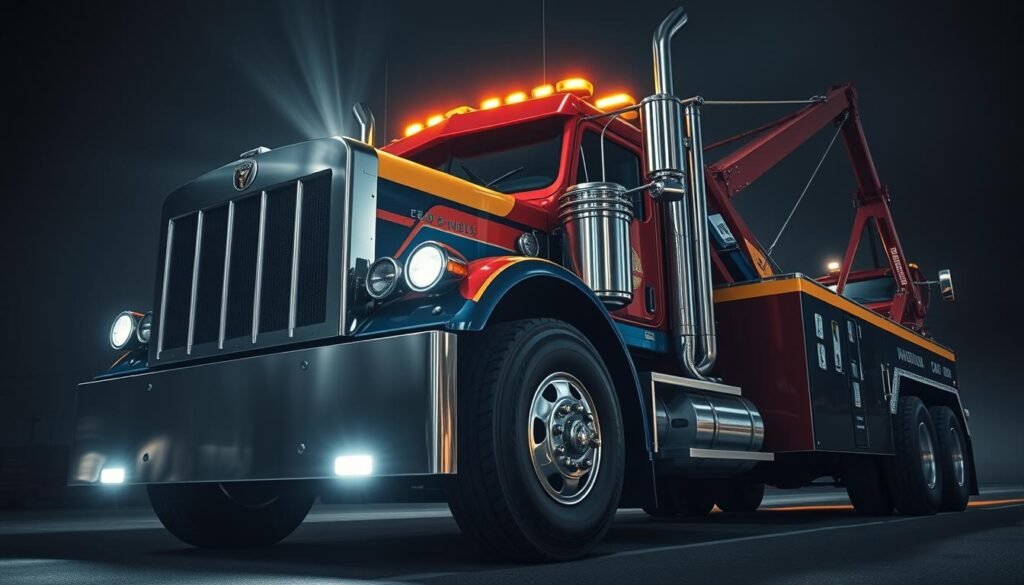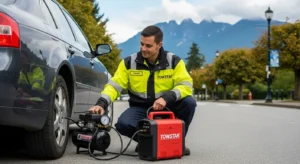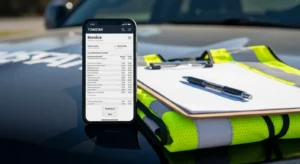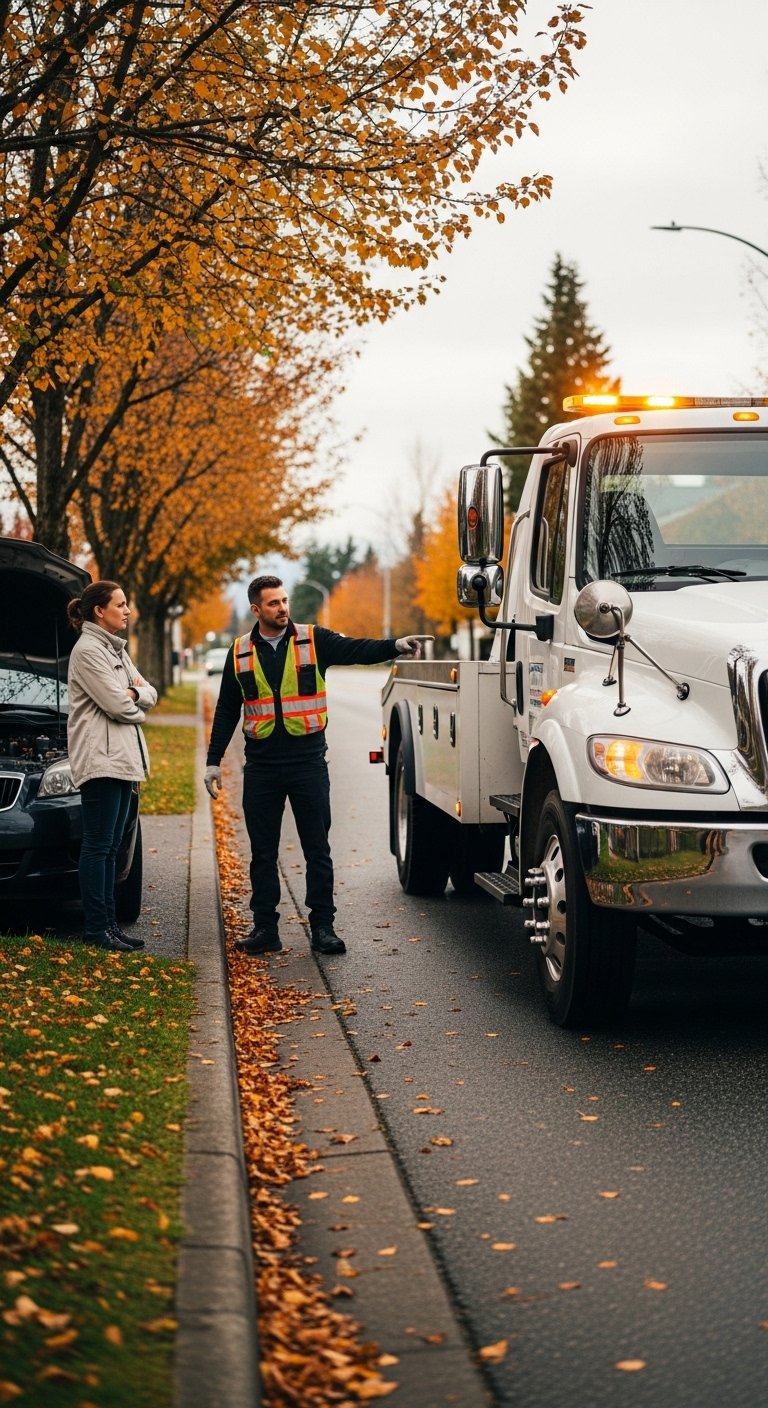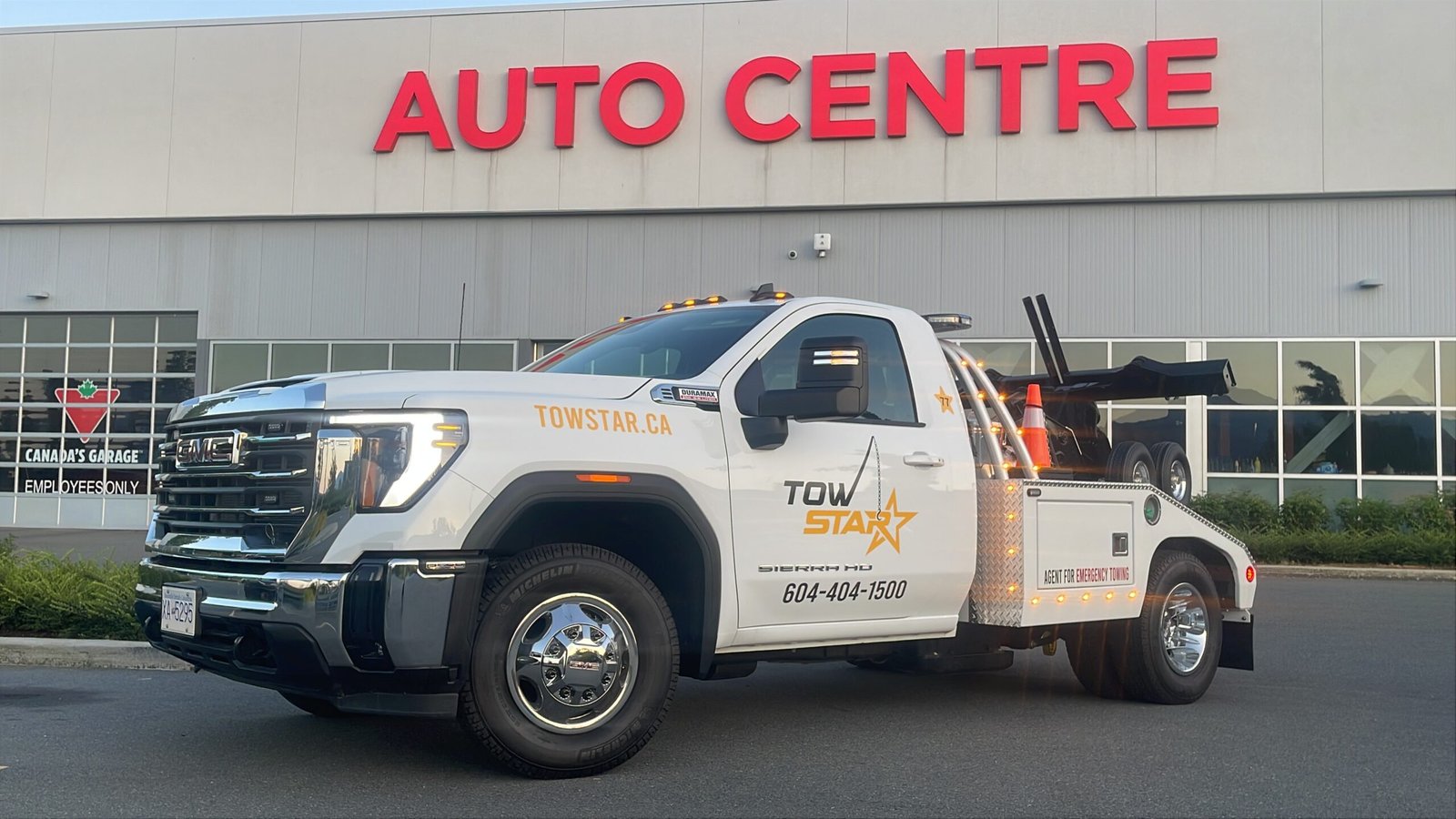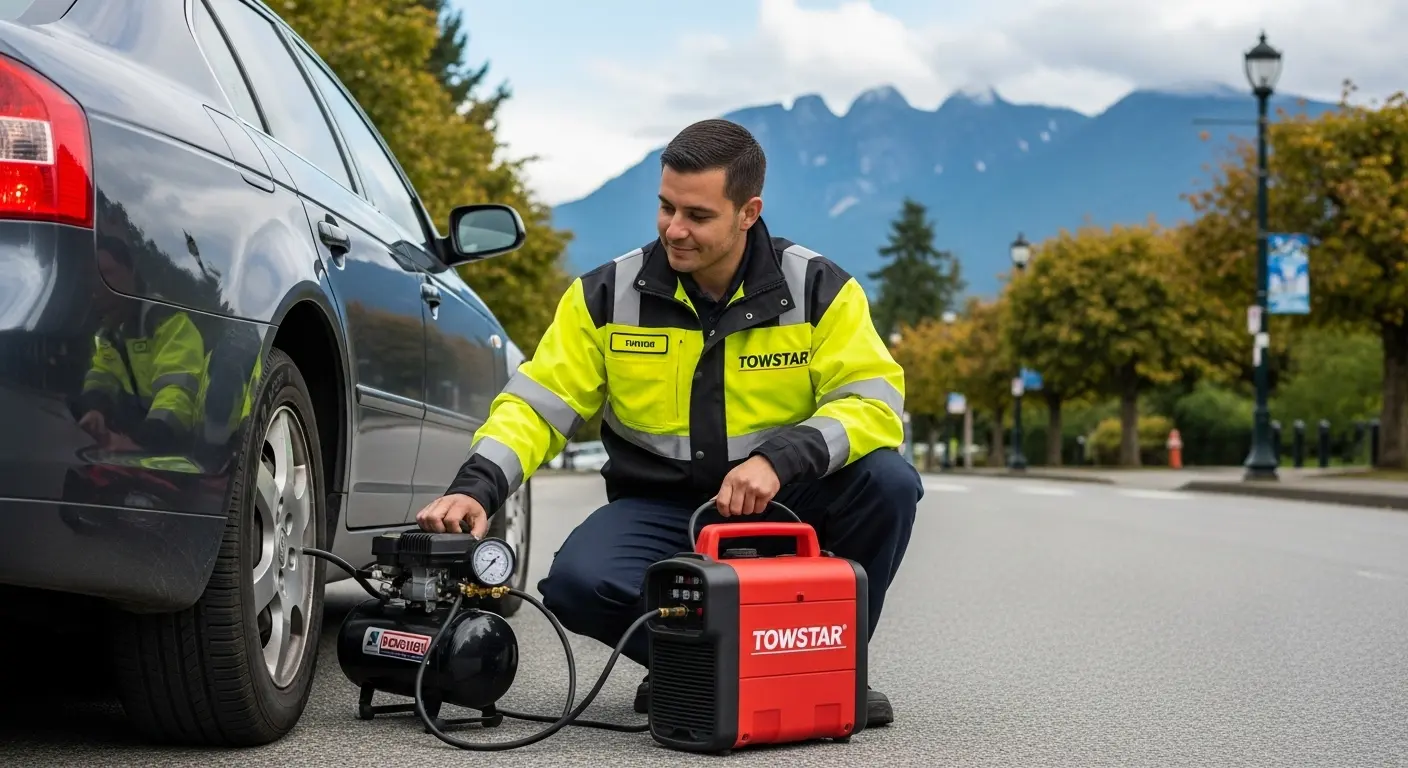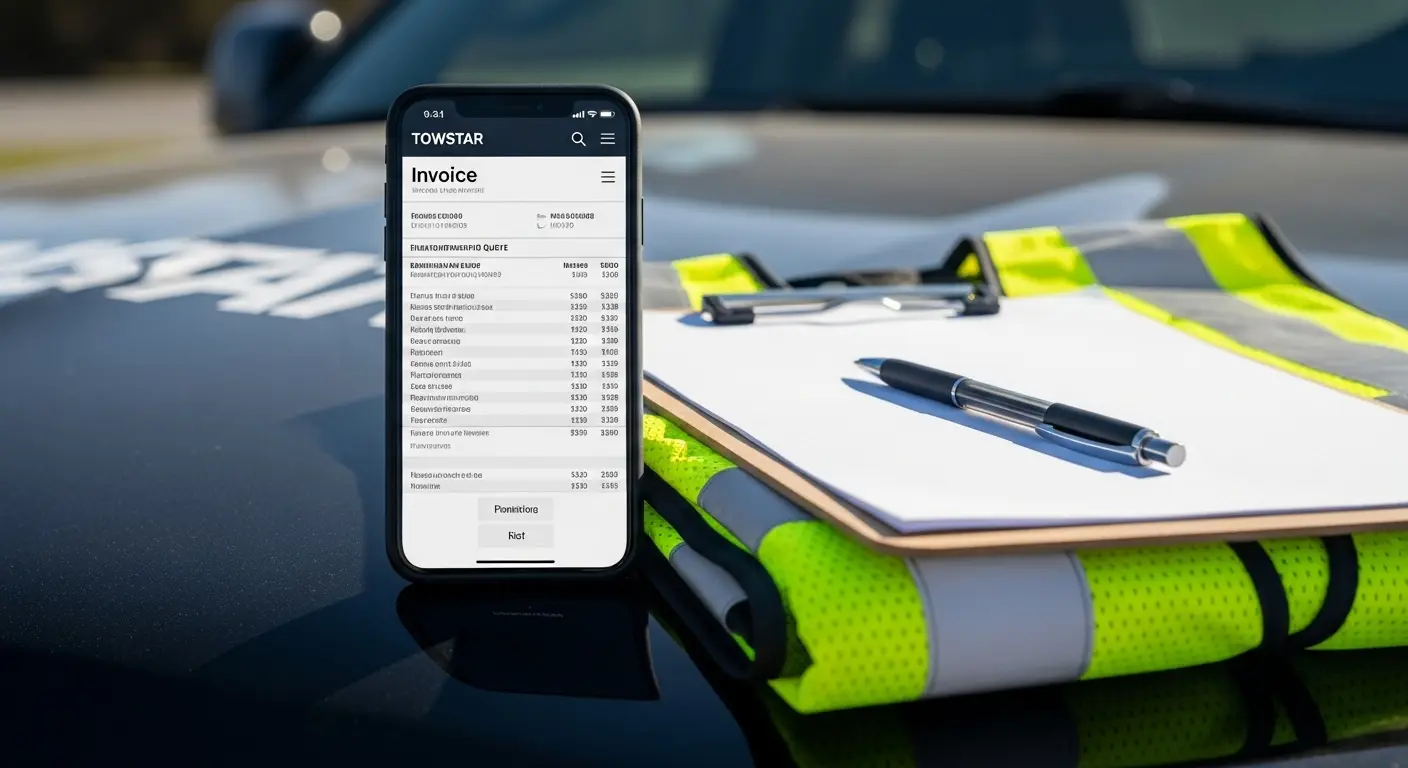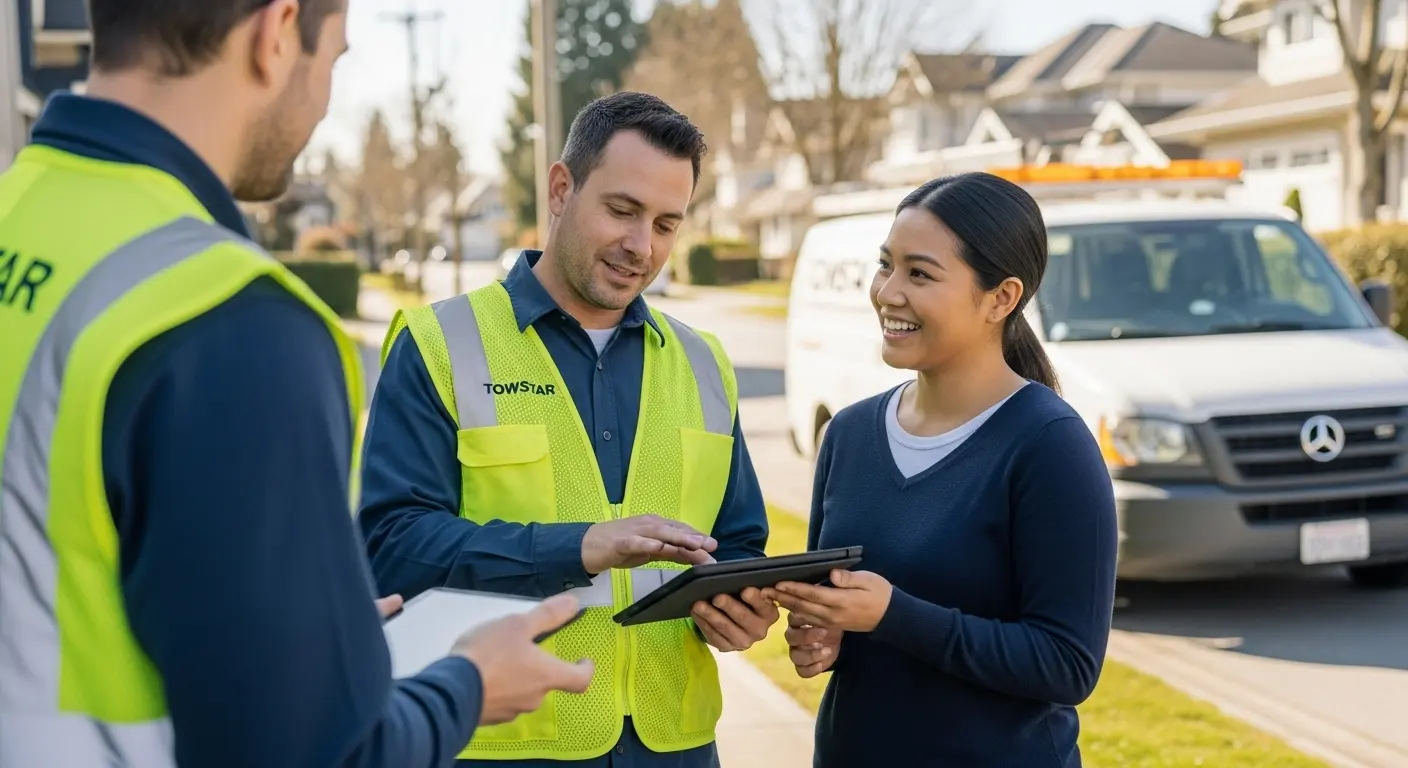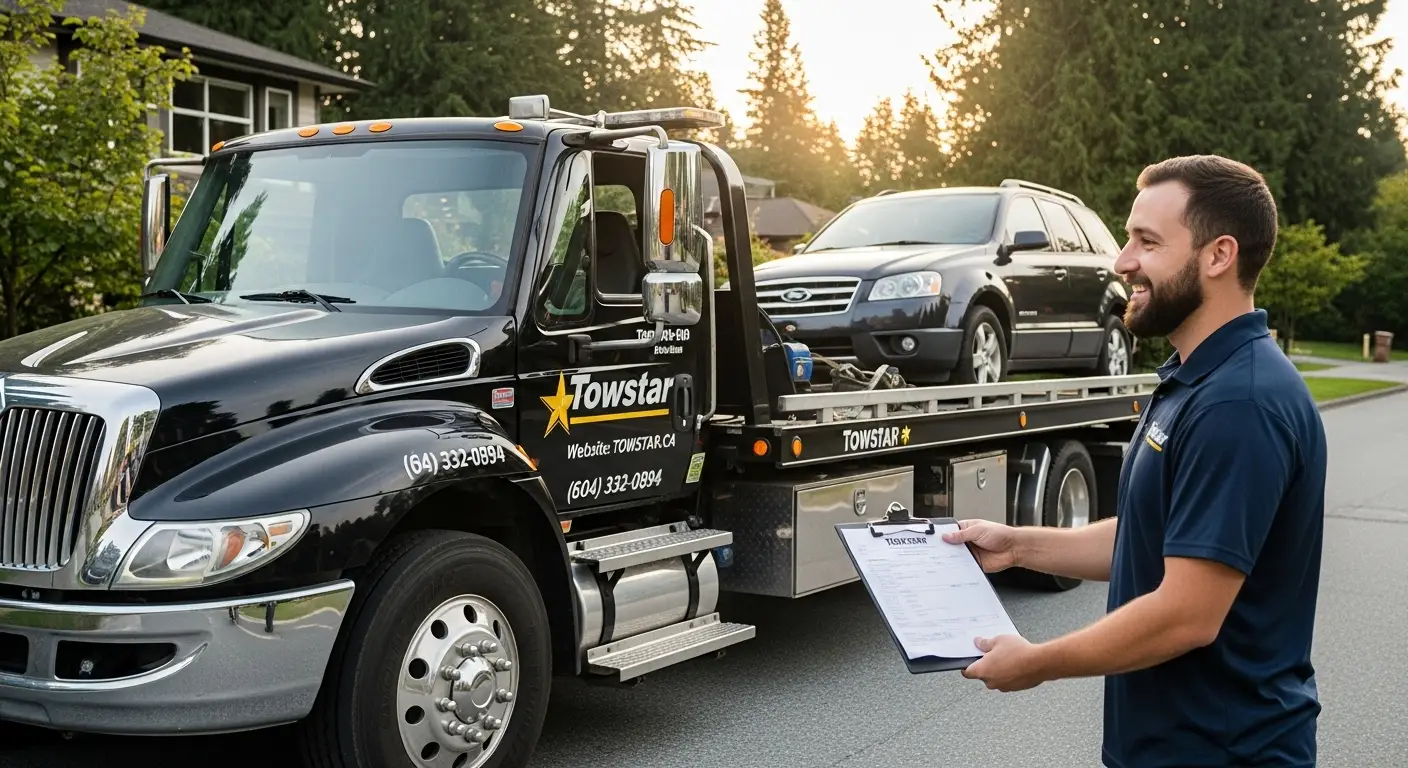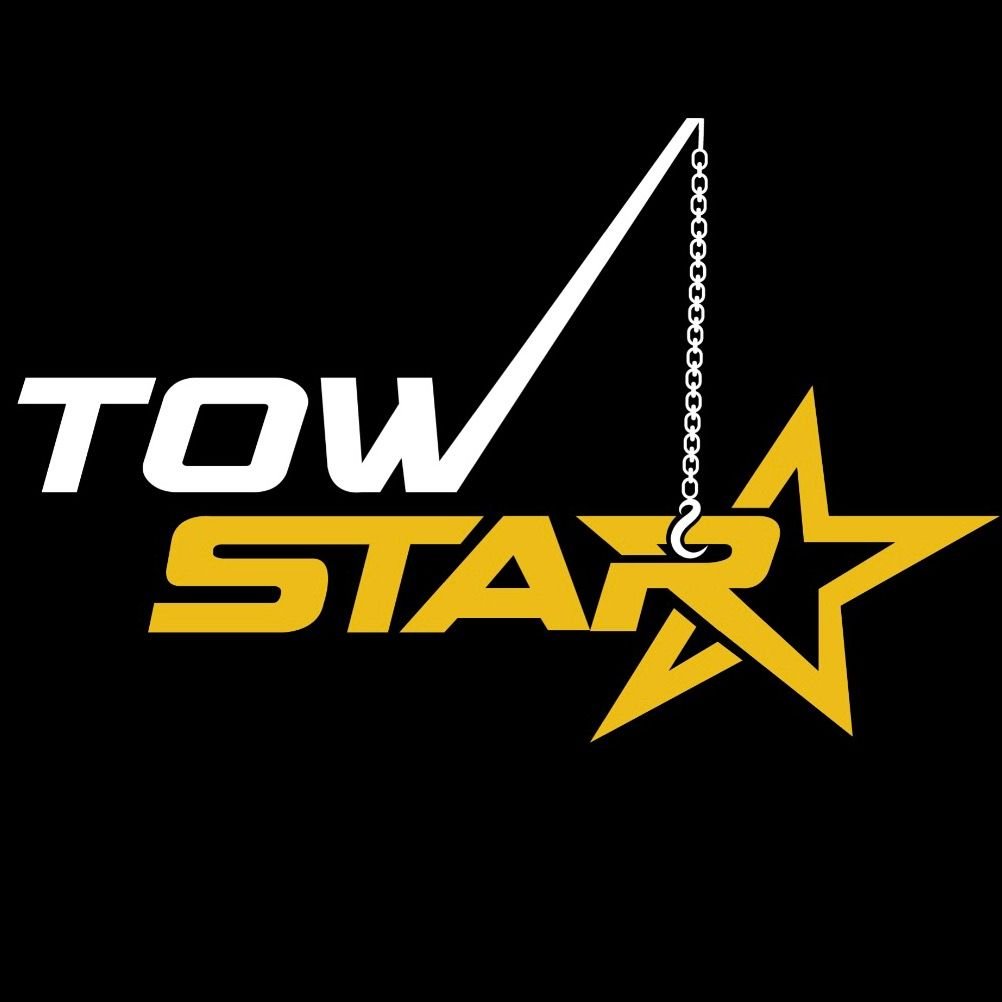Imagine driving a trailer full of gear through British Columbia’s mountains. Your pickup starts to sway, and you feel your heart racing. It’s clear that your vehicle might not be up for the task.
When it comes to towing 12,000 lbs, the type of vehicle matters more than its size. While some big pickups look strong, they often can’t handle more than 15,000 lbs. Heavy-duty tow trucks, on the other hand, are built for much heavier loads, from 5,000 to 40,000+ lbs. Using the wrong vehicle can be dangerous and even illegal under Canada’s towing laws.
Many people think that a bigger truck means a safer haul. But the truth is, your vehicle’s towing capacity depends on its strength, brakes, and hitch. Trying to tow 12,000 lbs with standard equipment is like using duct tape on a transmission. It might seem to work at first, but it won’t end well.
Key Takeaways
- Vehicle class determines safe weight limits, not just size
- Most pickups can’t legally handle 12,000 lbs in Canada
- Professional services use specialized rigs for heavy loads
- Hidden risks include brake failure and insurance voids
- Always check your owner’s manual and provincial laws
Next time you need to move heavy loads, think carefully. Is your pickup really up to the job? Or do you need heavy-duty equipment? Choosing the right vehicle is important to avoid a disaster on the road.
Understanding Heavy Duty Tow Trucks
Heavy duty tow trucks are the heroes of roadside recovery. They have the strength and tech to tackle Canada’s toughest towing jobs. These trucks can haul 12,000 lbs or more, making them essential.
What Defines a Heavy Duty Tow Truck?
These trucks are like the SWAT team of towing. They stand out in three ways:
- Industrial-grade frames: Reinforced steel skeletons prevent bending under massive loads
- Professional certifications: Built to meet Transport Canada’s strict commercial vehicle standards
- Specialized attachments: From wheel lifts to hydraulic boom systems, they’re ready for complex recoveries
Key Features of Heavy Duty Tow Trucks
Modern winch trucks have smart tech and power. Here’s what’s under their rugged exteriors:
| Feature | Purpose | Example |
|---|---|---|
| Turbo diesel engines | Delivers torque for uphill hauls | 450+ horsepower models |
| Adjustable gooseneck trailers | Secures oversized loads | 360-degree pivot points |
| Multi-camera systems | Eliminates blind spots during recovery | Night vision capable |
| Load stabilizers | Prevents sway at highway speeds | Automatic pressure adjustment |
These features are why provinces like Alberta need heavy duty rigs for mountain towing. The right equipment keeps everyone safe on the road.
Advantages of Heavy Duty Tow Trucks
When you’re dealing with massive loads, heavy duty tow trucks are a must. They handle weights that would make regular trucks struggle. This is because they’re built for commercial towing. They’re the safer, smarter choice for moving 12,000 lbs or more.
Capacity and Efficiency
Heavy duty wreckers are not just for towing. They’re built for heavy lifting. Their power and design make them stand out:
- GCWR up to 60,000 lbs (Gross Combination Weight Rating) for moving large vehicles or equipment
- Optimized axle ratios that distribute weight evenly across all wheels
- Diesel engines with torque outputs triple those of standard pickup trucks
It’s not just about strength. These trucks have reinforced frames and commercial-grade hitches. This means they stay in control, even when hauling near maximum capacity. You’ll spend less time worrying about strain and more time getting jobs done.
Safety Features and Reliability
When lives and cargo are at risk, heavy duty tow trucks have safety tech you won’t find in regular cars:
- Stability control systems that auto-adjust to shifting loads
- Anti-lock brakes (ABS) calibrated for sudden stops with heavy trailers
- Reinforced cab structures meeting commercial safety standards
These features aren’t just fancy extras. They’re why wrecker services trust these trucks in emergencies. You get 360° protection: for your load, your crew, and everyone sharing the road.
Understanding Pickup Trucks
When your car breaks down on a cold Alberta highway, or you need to carry camping gear, pickup trucks are there for you. They offer both everyday use and some muscle for light tasks. But, it’s important to know what they can handle before towing a trailer.
What Exactly Makes a Pickup Truck?
A pickup truck has a passenger area and an open cargo bed. There are two main types on Canadian roads:
- Mid-size models: Think Ford Ranger or Toyota Tacoma – great for city driving
- Full-size beasts: Like RAM 1500 or Chevrolet Silverado, made for heavy loads
| Feature | Mid-Size | Full-Size |
|---|---|---|
| Avg. Towing Capacity | 6,000-7,500 lbs | 9,000-13,000 lbs |
| Fuel Efficiency | 20-25 MPG | 15-20 MPG |
| Bed Length | 5-6 ft | 6.5-8 ft |
Where Pickups Shine (And Where They Don’t)
Your pickup’s bed is like a Swiss Army knife for Canadian life:
- Helping neighbors move furniture in Ottawa suburbs
- Hauling snowmobiles to Quebec trails
- Carrying landscaping supplies across Vancouver Island
For roadside help, pickups are good at light tasks – like pulling a car from a snowy ditch. But, towing a 12,000-lb trailer is risky. Always check your truck’s towing guide (in the glovebox) before towing heavy loads.
Advantages of Pickup Trucks
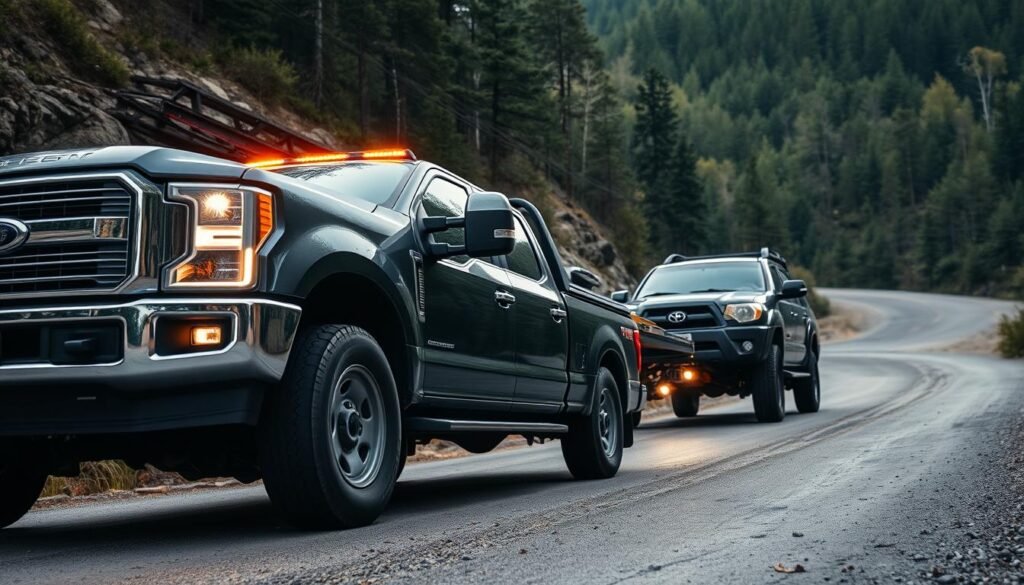
Think pickup trucks are just for hauling lumber or weekend adventures? Think again! These vehicles are great for towing without spending a lot. They are like the Swiss Army knives of light-duty hauling.
Versatility and Accessibility
Your pickup isn’t just for towing. It’s your daily driver, grocery getter, and family road trip machine. Unlike heavy-duty rigs, you can:
- Switch from towing trailers to carrying bikes in under 10 minutes
- Navigate tight city streets and standard parking spots
- Handle DIY projects and your kid’s hockey gear simultaneously
Flatbed towing is easy with modern pickups. Many models are pre-wired for trailer lights. Their lower deck heights make loading motorcycles or furniture easy.
Cost-Effectiveness for Light Loads
Pickups are better than heavy-duty options for lighter jobs. Let’s look at the numbers:
| Expense | Pickup Truck | Heavy-Duty Tow Truck |
|---|---|---|
| Fuel Cost (100km) | $18-$25 | $35-$50 |
| Annual Maintenance | $800-$1,200 | $2,500-$4,000 |
| Insurance (Monthly) | $150-$250 | $400-$600 |
For loads under 8,000 lbs, you’ll save nearly 40% on costs. You won’t pay for power you don’t need. That extra cash can go towards actual towing jobs!
Pro Tip: Use your pickup’s factory-installed tow package whenever possible. Aftermarket modifications can void warranties and eat into those sweet savings.
Comparing Towing Capacities
When your load is as heavy as a small elephant, knowing your vehicle’s limits is essential. Let’s look at what heavy-duty tow trucks and pickup trucks can really handle. One is for weekend projects, the other for big rescues.
Heavy Duty Tow Truck Towing Specifications
These trucks are called “heavy-duty” for a reason. They’re built to handle Canada’s toughest jobs. Their specs are impressive:
- 12,000–60,000 lbs towing capacity (depending on model)
- Dual rear wheels for stability at highway speeds
- Air-brake systems matching commercial semi-trucks
Need to move a stranded excavator or overturned tractor trailer? That’s when professional heavy hauling services are needed. Their trucks have special cooling systems for heavy pulls.
Pickup Truck Towing Specifications
Your average pickup might impress at the campground. But let’s look at real numbers:
| Pickup Model | Max Towing | Real-World Limit |
|---|---|---|
| Half-Ton | 8,000–12,000 lbs | 6,500 lbs |
| Heavy-Duty Pickup | 14,000–18,000 lbs | 12,000 lbs |
See the “real-world limit” column? That’s why smart towers leave a 20% buffer. Your pickup might technically handle 12,000 lbs, but stopping that load on a snowy BC highway is a different story.
Safety Considerations in Towing
When towing heavy loads, safety is not just a checklist item. It’s your lifeline. We’ll look at two key factors to keep you and your cargo safe. This is true whether you’re on rocky trails or icy Canadian backroads.
Load Distribution and Balance
Imagine carrying a wobbly grocery bag up a ski slope. That’s what bad weight distribution feels like to your truck! For off-road towing, the 60/40 rule is key: 60% of the load should be in front of the trailer axles. If you get this wrong, you could face dangerous swaying or even rollovers.
- Use load-leveling hitches for uneven terrain
- Check tire pressure after loading
- Secure loose items with ratchet straps
Safety Features in Heavy Duty Tow Trucks
Modern heavy-duty rigs have tech that’s like something out of a spy movie. These aren’t just fancy gadgets. They’re your invisible co-pilot when facing steep inclines or muddy paths:
- Auto-sway control that corrects trailer wobble
- 360° camera systems for blind spot elimination
- Hill descent assist for slippery slopes
Pro tip: Always test your truck’s emergency braking system before heading into remote areas. It’s like checking your snow tires – annoying until you need it!
Use Cases for Heavy Duty Tow Trucks
Imagine trying to lift a moose with a bicycle – that’s why heavy-duty tow trucks exist. These rigs aren’t just bigger versions of pickup trucks. They are specialized tools for jobs where regular towing methods fail. Let’s explore when you need this level of muscle.
Ideal Scenarios for Heavy Duty Towing
You’ll want professional commercial towing services when:
- Moving oversized vehicles like buses or construction equipment
- Recovering vehicles from serious accidents or rollovers
- Transporting loads exceeding 12,000 lbs safely
- Handling dangerous cargo spills on highways
- Navigating tight recovery spaces (think ditches or steep slopes)
Industries that Rely on Heavy Duty Tow Trucks
Certain Canadian sectors literally can’t operate without these beasts:
- Construction: Hauling excavators and bulldozers between sites
- Transport: Rescuing semi-trucks with cargo intact
- Agriculture: Moving combines during harvest season
- Municipal services: Clearing accident scenes quickly
Here’s the kicker – provincial laws often require heavy-duty rigs for certain recovery jobs. Using a pickup truck in these situations isn’t just risky; it could land you with fines. When safety and legality collide, heavy-duty towing isn’t optional – it’s your smartest move.
Use Cases for Pickup Trucks
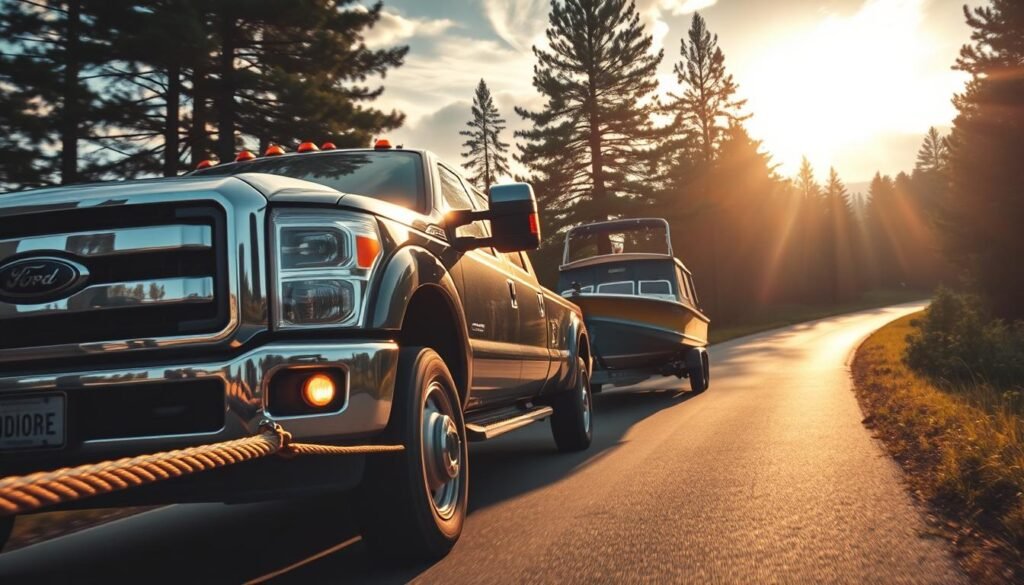
Your pickup truck is more than just a car. It’s your reliable sidekick for all sorts of tasks. While big trucks handle heavy loads, your pickup is perfect for lighter tasks. It’s where versatility meets practicality.
Common Scenarios for Pickup Towing
There are many times your pickup truck proves its worth. It’s great for:
- Launching boats at cottage country lakes
- Moving furniture for friends across town
- Towing small campers for family getaways
- Hauling landscaping materials for DIY projects
Applicability in Everyday Situations
What makes pickups ideal for daily tasks? They offer three main benefits:
- Easy parking at grocery stores/hardware shops
- Fuel efficiency compared to heavy-duty alternatives
- Instant availability – no special permits required
Hidden Risks in “Simple” Towing: That couch haul for your buddy? Make sure the weight is evenly distributed. Towing a jetski to the lake? Check your brakes first. Having roadside assistance is key when unexpected problems pop up.
Cost Analysis: Heavy Duty vs Pickup
Let’s talk dollars and sense. Choosing between a heavy-duty tow truck and a pickup for hauling 12,000 lbs has different costs. We’ll look at both the upfront costs and hidden expenses to see where your money goes.
Initial Investment and Financing
Heavy-duty tow trucks are serious business with big price tags. Expect to spend $150,000-$300,000 CAD for a new one. Financing can take 5-7 years, with rates between 6-9%.
But there’s a catch: many provinces require CDL licensing for these vehicles. This adds $2,000-$5,000 in training costs.
| Cost Factor | Heavy Duty Tow Truck | Pickup Truck |
|---|---|---|
| Base Price | $150k-$300k | $50k-$80k |
| Financing Term | 5-7 years | 3-5 years |
| Mandatory Training | Yes (CDL required) | No |
Pickups are more accessible. A capable 3/4-ton truck starts around $50,000 CAD, with financing as low as 4.9% APR. No special licenses are needed in most provinces. Just hook up your trailer and go.
But wait until you see the long-term picture…
Long-Term Operation Costs
Fuel bills tell the real story. Heavy-duty trucks use 6-8 MPG diesel, while pickups use 12-15 MPG. But maintenance is another story:
- Tow trucks: $0.50-$0.70/km maintenance costs (built for constant use)
- Pickups: $0.25-$0.40/km (until you overload them)
Wrecker service partnerships can be a good deal. Paying $300-$500 per heavy tow might be cheaper than owning a truck if you only haul occasionally. But for daily use, a pickup’s transmission replacements ($8k-$12k CAD) add up fast when pushing weight limits.
Pro tip: Calculate your annual towing needs. More than 50 heavy loads/year? Owning makes sense. Less? A reliable wrecker service could save you $15k-$20k annually in depreciation and storage costs. Your wallet will thank you either way!
Maintenance and Durability
Your vehicle’s maintenance routine is key to its roadside performance. Skipping oil changes or ignoring warning signs can lead to needing a rescue. Let’s explore what keeps these machines running through Canadian winters and heavy workloads.
What Heavy-Duty Recovery Vehicles Demand
These machines need strict care schedules. Missing a service interval can lead to:
- Hydraulic system failures during critical recovery operations
- Premature brake wear from constant stop-and-go towing
- Frame stress cracks developing undetected
Keeping Pickups Towing-Ready
While less demanding than heavy-duty vehicles, pickup maintenance is important:
- Transmission fluid changes every 40,000-60,000 km when towing regularly
- Monthly tire pressure checks (cold weather affects PSI dramatically)
- Battery terminal cleaning to prevent corrosion from road salt
Pro Tip: Always use manufacturer-approved coolant in extreme temperatures. Mixing types can create sludge that clogs your engine’s arteries.
Regulations and Licensing for Towing
Understanding towing rules in Canada is easier than solving a maple syrup mystery. Whether you’re moving heavy loads or doing weekend projects, knowing the law keeps things running smoothly. It also protects your wallet from unexpected fines.
Required Licenses for Heavy Duty Towing
Driving heavy duty trucks for commercial towing? You need more than just strength. In most Canadian provinces:
- A Class 1 or 3 license with air brake endorsement
- Annual safety certifications for vehicles over 4,500 kg
- Special permits for loads exceeding provincial weight limits
Pro tip: Alberta and Ontario need extra training for oversized loads. Always check your province’s transport website for updates.
Pickup Truck Towing Regulations in Canada
Your reliable pickup has rules too – even for hauling firewood. Key points for personal use:
| Vehicle Type | Max Weight Allowed | License Class |
|---|---|---|
| Half-Ton Pickup | 3,400 kg | Class 5 |
| Heavy Duty Pickup | 5,900 kg | Class 5 (with trailer endorsement) |
| Commercial Use | Any weight | Class 1/3 + business license |
Remember: Overloading your pickup can void your insurance quickly. Use certified weight scales for heavy hauling jobs.
Making the Right Choice for Your Needs
Deciding between a heavy-duty tow truck and a pickup depends on your needs. Think about what you’re hauling, where you’re going, and how often you’ll need towing power. A Ford F-350 might work for occasional loads, but for off-road towing or heavy recoveries, a winch truck is better.
Factors to Consider When Choosing
First, think about your usual towing jobs. If you’re moving construction equipment in Alberta’s rocky terrain or rescuing stuck vehicles in Ontario’s cottage country, durability is key. Check the payload limits, hitch types, and braking systems. Also, look for safety certifications like CVOR licences for commercial operators.
Future-Proofing Your Towing Options
Your needs might change in the future. A RAM 2500 is good for light trailers now, but you might need more for industrial contracts later. Look for gear that can be upgraded, like reinforced frames or hydraulic lifts. Choose providers that offer scalable solutions for changing jobs.
Not sure what to choose? Get a free consultation. We’ll look at your routes, loads, and budget to find the right fit. Whether it’s a winch truck rental or a long-term plan for off-road towing, we’ll help you grow as fast as your ambitions.
FAQ
Can a pickup truck safely tow 12,000 lbs?
Most consumer pickups can’t legally or safely handle 12,000 lbs. Some heavy-duty models get close but lack the safety features of heavy duty tow trucks. These trucks have reinforced frames and advanced systems for safe heavy hauling.
What makes heavy duty tow trucks different from regular trucks?
Heavy duty rigs have industrial-grade components like dual rear wheels and hydraulic lift systems. They are built for emergency heavy hauling with safety systems to prevent dangerous load shifts during commercial towing operations.
When do I legally need a heavy duty tow truck in Canada?
You’ll need a professional wrecker service for loads over 10,000 lbs GVWR, oversize cargo, or hazardous materials. Canadian regulations require specific licensing and equipment for these scenarios to protect public safety.
Why choose a pickup for flatbed towing instead of a heavy duty rig?
Pickups are great for light-duty flatbed towing for personal vehicles or small equipment. They are more affordable and accessible for occasional use under 8,000 lbs. Always check your truck’s towing capacity and hitch ratings first.
How do professional winch trucks handle off-road towing challenges?
Heavy duty recovery vehicles use planetary gear winches with 360° rotation and load monitoring systems. These features allow safe extraction in mud, ditches, or steep terrain where consumer trucks would fail.
What maintenance keeps heavy hauling equipment road-ready?
Professional wrecker services perform daily brake checks, weekly hydraulic inspections, and monthly frame integrity scans. This maintenance prevents breakdowns during critical roadside assistance calls and extends equipment lifespan.
Can I save money using my pickup for commercial towing jobs?
While tempting, using consumer trucks for paid heavy hauling often leads to costly repairs and liability issues. Professional-grade equipment carries proper insurance and meets all commercial towing regulations – protecting your business and clients.
How does load distribution affect towing safety?
Proper weight balance prevents dangerous trailer sway and brake failure. Heavy duty tow trucks use load-sensing axles and electronic stability control – systems most pickups lack. Always calculate tongue weight and trailer balance before moving any load.
What hidden costs come with DIY heavy hauling?
Beyond fines for improper equipment, amateur towing risks costly damage to your vehicle, trailer, and cargo. Professional services include insurance coverage and often prevent expensive roadside disasters through proper equipment and training.
How often should I service my pickup’s towing components?
Inspect brakes, bearings, and cooling systems after every heavy haul. For frequent flatbed towing users, complete professional inspections every 5,000 km or 3 months. Remember – worn components fail faster under heavy loads!

